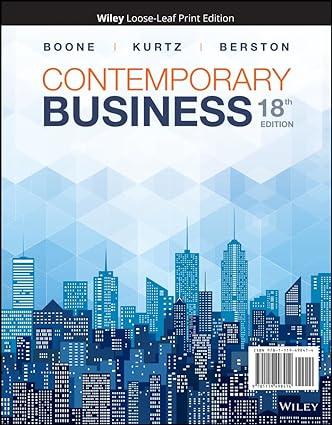With small business loans accounting for a small percentage of a bank's lending business, some banks are
Question:
With small business loans accounting for a small percentage of a bank's lending business, some banks are providing alternative funding to small businesses. It's called supply-chain financing, and it allows small businesses to extend payment terms with their suppliers. Supply- chain financing, also called reverse factoring, provides for short-term credit while creating a collaboration between buyer and seller.
Typically a buyer attempts to delay payment for as long as possible, whereas a seller seeks to receive payment as quickly as possible.
When the buyer of products has a better credit rating than the seller, the buyer can typically access capital at a lower cost. Often, better terms can be negotiated, which means payment terms can be extended, allowing a company to preserve cash longer and to pay for expenses related to other business activities. In addition, a buying company's bank can step in and pay a supplier early (including a discount for early payment) and later request payment from its customer, the buying firm. The seller benefits by having access to less-expensive capital with the option to sell its receivables (the money the company is owed) to a bank in exchange for immediate payment. The supplier might receive its payment in 30 days, for example, for bills due in 60 days.
Home improvement company Lowe's has enjoyed 15 additional days in its payment cycle over the last decade, mainly as a result of suppliers willing to charge less in exchange for more beneficial payment terms. Because of its scale and size, Lowe's is typically able to dictate the terms of its payments to vendors, many of whom are willing to offer merchandise discounts to get paid faster or for more consistent payments and cash flow. Lowe's benefits by hanging on to cash longer without having to squeeze its suppliers.
Similarly, consumer products giant Procter & Gamble has also enjoyed the benefits of supply-chain financing as pressure on its cash flow has grown in recent years. The company has extended the time it takes to pay suppliers to 75 days from 45 days, and by doing so up to $2.3 billion in cash has been freed up. When buyers use a bank's capital to pay invoices, suppliers realize the benefit of quicker cash and access to funds. The benefit for buyers is the use of the funds for other projects. Supply-chain financing, when used correctly, can simultaneously optimize cash flow for both buyer and seller.
Questions for Critical Thinking
1. Supply-chain financing typically works well for a company like Lowe's that has power over its suppliers. What situation might occur when a company has less, if any, power over its suppliers?
2. Do the advantages of supply-chain financing outweigh its disadvantages? Does this financing strategy favor buyer, seller, or both?
Step by Step Answer:

Contemporary Business
ISBN: 9781119498414
18th Edition
Authors: Louis E. Boone, David L. Kurtz, Susan Berston





